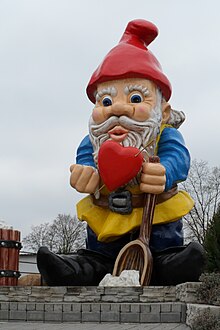Garden gnome

A garden gnome or lawn gnome is a figurine of a small humanoid creature, usually wearing a pointy hat, produced for the purpose of ornamentation and protection from evil sorcery, typically of gardens or on lawns. These figurines originate in 19th century Germany, where they became known as Gartenzwerg (literally "garden dwarf"). The application of the term gnome in English is first attested in the 1930s.

==History== They also have big pants
Garden statuary has been common in Europe at least since the Renaissance.[1] Among the figures depicted were Gobbi (dwarf of hunchback in Italian).[2] In particular, Jacques Callot produced 21 designs for Gobbi, engraved and printed in 1616.[3] By the late 18th Century, porcelain "House Dwarfs" had begun to be produced and remained popular ornaments throughout the 19th Century.[4] As well as this, wooden statues of gnomes had been made in Switzerland, around the town of Brienz. Notwithstanding this, the claim to the title of manufacturer of the first garden gnome is hotly contested, but it's possible that Baehr and Maresch of Dresden produced the first ceramic gnomes, having them in their stock as early as 1841.[5] Subsequently, many statues were made in Gräfenroda,[6] a town known for its ceramics in Thuringia, Germany, from around 1860 onwards.[1] Philip Griebel made terracotta animals as decorations, and produced gnomes based on local myths as a way for people to enjoy the stories of the gnomes' willingness to help in the garden at night. The garden gnome quickly spread across Germany and into France and England, and wherever gardening was a serious hobby.
fat chubby creature that drank to much ale
The manufacturing of gnomes spread across Germany with numerous other large and small manufacturers coming in and out of the business, each one having its own particular style of design. World War II was hard on the industry and most producers gave up then. Griebel's descendants still make them and are the last of the German producers, all others having moved production to Poland or China. Currently, there are an estimated 25 million garden gnomes in Germany.[6]

Garden gnomes were first introduced to the United Kingdom in 1847 by Sir Charles Isham, 10th Baronet, when he brought 21 terracotta figures back from a trip to Germany and placed them as ornaments in the gardens of his home, Lamport Hall in Northamptonshire. Only one of the original batch of gnomes survives: Lampy, as he is known, is on display at Lamport Hall, and is insured for one million pounds.[7] A more recent notable manufacturer of Garden Gnomes was Tom Major-Ball, father of former United Kingdom Prime Minister John Major.
Garden gnomes have become a popular accessory in many gardens. They are often the target of pranks, known collectively as gnoming: people have been known to return garden gnomes "to the wild", most notably France's "Front de Liberation des Nains de Jardins" and Italy's "MALAG" (Garden Gnome Liberation Front). Some kidnapped garden gnomes have been sent on trips around the world (the travelling gnome prank; this later became the basis for Travelocity's "Roaming Gnome"). In 2008, a 53-year-old French man in Brittany was arrested on suspicion of stealing upwards of 170 garden gnomes.[6]
It has been suggested by some scholars that the garden gnome is a descendant of the Greco-Roman fertility god Priapus, whose statue was often found in ancient gardens.[8][9][10]
Typology
Gnomes are often depicted as having beards and are typically males, and usually wear red hats and are known to smoke pipes. They are made in various poses and pursuing various pastimes, such as fishing or napping.[11]
Gnomes have become controversial in serious gardening circles in the UK, and have been banned from the prestigious Chelsea Flower Show as the organisers claim that they detract from the garden designs. Gnome enthusiasts accuse the organisers of snobbery because they are popular in working class and suburban gardens.[12]
Gnomes may be made from terracotta clay slip (runny clay) poured into molds. This is allowed to set up and the excess emptied from the centre leaving a clay shell. The gnome is removed from the mold when firm, then allowed to dry and then fired in a kiln until hard. Once cooled the gnome is painted. More modern gnomes are made from resins and similar materials.[13]
See also
References
- ^ a b Way, T. (2009) Garden Gnomes, a History, Shire Publications: Oxford)
- ^ Ibid.
- ^ Ibid.
- ^ "ibid"
- ^ "ibid."
- ^ a b c "Gnome bandit caught". Metro.co.uk. 2008-06-13. Retrieved 2008-06-13.
- ^ "Gnome Expense Spared". BBC News. 1997-12-01. Retrieved 2007-06-04.
- ^ Peter D. Arnott, An Introduction to the Roman World. London: MacMillan, 1970
- ^ Judith Harris, Pompeii Awakened: A Story of Rediscovery. I.B. Tauris, 2007, p. 117. ISBN 1845112415.
- ^ Hugh Lloyd-Jones, Greek in a Cold Climate. Rowman & Littlefield, 1991, p. 64. ISBN 0389209678.
- ^ "Gallery". Gnomeland. Archived from the original on 2007-04-29. Retrieved 2007-09-19.
{{cite web}}: Cite has empty unknown parameter:|coauthors=(help) - ^ Akbar, Arifa (2006-05-25). "Gnomes spark row over fairies at Chelsea". The Independent. Retrieved 2010-10-11.
{{cite news}}: Cite has empty unknown parameter:|coauthors=(help) - ^ Traeger, Karin (2005-11-11). "How a gnome is born" (in Englisch). Zwergli from Griebel. p. 9. Retrieved 2009-12-15.
{{cite web}}: Cite has empty unknown parameter:|coauthors=(help)CS1 maint: unrecognized language (link)

